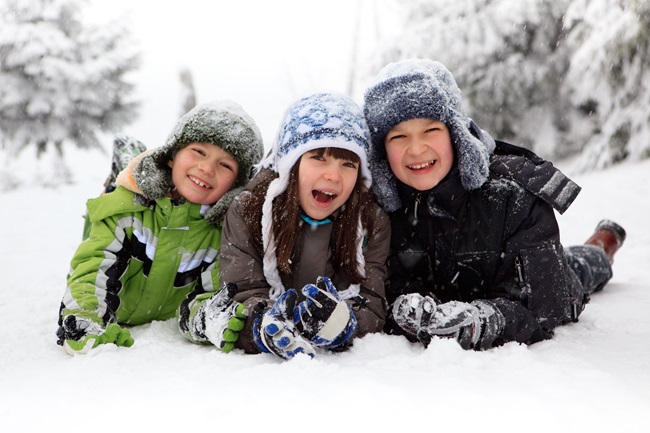Winter brings the excitement of snow days, and playing in the snow is a fun and healthy way for kids to enjoy the season. However, snowy conditions come with unique safety considerations. Here are essential snow safety tips to help ensure that your children have a safe and enjoyable time playing outdoors.
1. Dress in Warm, Layered Clothing
Keeping kids warm and dry is the first step to safe snow play:
- Layer Up: Start with a moisture-wicking base layer, followed by an insulating layer, and finish with a waterproof outer layer.
- Cover Extremities: Use hats, gloves, and warm socks to protect areas most vulnerable to the cold, like fingers, toes, and ears.
- Choose Waterproof Gear: Waterproof gloves, boots, and jackets are essential to keep kids dry and prevent frostbite.
Layered, waterproof clothing keeps kids warm, dry, and comfortable while they play in the snow.
2. Set Time Limits to Avoid Frostbite and Hypothermia
Prolonged exposure to cold temperatures can lead to frostbite or hypothermia, so monitor playtime:
- Limit Outdoor Time: Set a time limit for outdoor play, typically 20-30 minutes at a time in very cold weather.
- Take Warm-Up Breaks: Encourage children to come indoors periodically to warm up with hot drinks or snacks.
- Watch for Warning Signs: Check for signs of frostbite, like pale or numb fingers and toes, and bring kids inside if they start shivering.
Setting time limits and taking breaks ensures kids stay warm and safe, preventing cold-related injuries.
3. Supervise Snow Play Activities
While snow offers plenty of opportunities for fun, adult supervision helps prevent accidents:
- Watch Sledding and Snowball Fights: Ensure children are sledding in safe areas and using snowballs made of soft, powdery snow, avoiding ice chunks.
- Check for Safe Terrain: Make sure kids are playing in areas free of rocks, trees, or other hazards that might be hidden under the snow.
- Discourage Playing Near Roads: Snow can reduce visibility, so keep children away from roads and driveways where vehicles might pass.
Supervision and safe play areas minimize the risk of accidents, allowing kids to enjoy the snow more safely.
4. Choose Safe Sledding Spots
Sledding is a favorite snow activity but requires careful attention to safety:
- Pick Gentle, Open Slopes: Find a sledding hill with a gentle slope and a long, flat stopping area at the bottom.
- Avoid Crowded Areas: Sledding can be chaotic, so choose a less crowded hill to reduce the chance of collisions.
- Teach Proper Sledding Techniques: Encourage kids to sit upright and face forward on the sled, avoiding lying down or going headfirst.
Choosing the right sledding area and teaching safe techniques helps prevent injuries.
5. Stay Hydrated, Even in Cold Weather
Cold weather can be deceptive, and kids can still become dehydrated while playing outdoors:
- Encourage Regular Water Breaks: Remind kids to take a few sips of water during breaks, as they may not feel as thirsty in the cold.
- Avoid Sugary or Caffeinated Drinks: Stick to water or warm, non-caffeinated drinks like herbal tea or diluted juice.
- Pack a Thermos: A thermos with warm water or herbal tea can encourage kids to stay hydrated and keep them warm.
Hydration is crucial even in winter, as it helps kids maintain their energy and avoid fatigue.
6. Use Sunscreen and Eye Protection
Snow reflects sunlight, increasing the risk of sunburn and eye damage from UV rays:
- Apply Sunscreen: Use sunscreen on exposed skin, including the face and neck, even on cloudy days.
- Wear Sunglasses or Goggles: Sunglasses with UV protection or snow goggles help protect kids’ eyes from glare and harmful UV rays.
- Reapply as Needed: If kids are out for an extended period, reapply sunscreen every couple of hours.
Sun protection helps prevent sunburn and eye strain, keeping kids safe from the sun’s winter glare.
7. Inspect and Maintain Snow Play Equipment
Snow play equipment, such as sleds or snow tubes, should be checked before use:
- Check for Cracks or Damage: Ensure sleds and tubes are in good condition without any cracks or sharp edges.
- Secure Snowshoes and Skis Properly: If kids are using snowshoes or skis, make sure straps and bindings are adjusted correctly.
- Clean and Dry Equipment After Use: Wipe down equipment after playtime to prevent ice buildup and rust.
Inspecting and maintaining equipment keeps it safe for use and extends its lifespan.
8. Teach Kids About Thin Ice
If your child will be near any bodies of water, it’s crucial to educate them about the dangers of thin ice:
- Stay Away from Ponds, Lakes, and Rivers: Unless the ice has been professionally tested and marked safe, children should stay off frozen water.
- Explain the Risks of Thin Ice: Teach kids to recognize that ice might look solid but can be deceptive, especially in early or late winter.
- Set Clear Boundaries: Identify areas where it’s safe to play and make sure they understand to stay within those limits.
Educating kids about thin ice is essential to preventing accidents and ensuring safe play.
Final Thoughts
Snowy days are a fantastic opportunity for kids to enjoy the outdoors, but safety should always come first. By dressing in layers, supervising play, setting time limits, and ensuring proper hydration, you can keep your kids safe while they explore the winter wonderland. With these precautions, they’ll be ready to enjoy a fun-filled and secure time in the snow.

